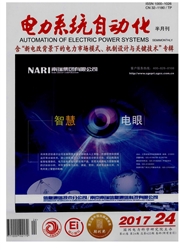

 中文摘要:
中文摘要:
双馈式感应发电机(DFIG)由于其定子直接与电网相耦合,电网故障将引起定子磁链暂态,并会在转子侧产生电压和电流冲击。传统基于Crowbar的低电压穿越(LVRT)解决方案不仅没能充分利用变流器对DFIG的控制灵活性,而且也难以较好地适应当今不断提升的并网要求。而当前基于灭磁控制的暂态补偿策略多依赖于磁链观测技术,不仅算法较为复杂而且对电机参数具有较强的依赖性。对电网电压发生跌落故障时定、转子电磁暂态过程进行了深入分析和讨论,并依据其暂态电磁特性,提出了一种基于虚拟电感暂态自灭磁算法的LVRT控制策略。该策略不仅能够较好地抑制转子暂态电压冲击,最大限度地拓展可穿越的故障范围,充分发挥DFIG的控制灵活性,而且无需暂态磁链观测,简化了算法,具有较好的快速性和鲁棒性。11kW模拟机组的仿真和实验,验证了所提出的分析和设计的正确性和可行性。
 英文摘要:
英文摘要:
Since the stator windings of doubly-fed induction generator (DFIG) are usually coupled with power grid directly, transient fluxes will occur in the stator windings upon grid faults,and as a result,it will cause transients in the rotor currents and voltages.The flexibility of DFIG control system has not been utilized very well in the conventional crowbar circuit based low-voltage ride through(LVRT) strategies and it is difficult to meet the increasingly stringent grid code requirements.Some transient flux compensation based LVRT strategies have been used for DFIG wind turbines,however,the dependence on stator flux linkages makes this type of algorithms complicated and sensitive to the DFIG parameters.Based on the analysis of the transient process of DFIG following grid faults,a novel LVRT control strategy based on virtual inductance self-demagnetization algorithm is proposed.With the proposed strategy,not only the transient voltage surge in the rotor is suppressed very well, enlarging the wind turbines to ride through most of grid faults,but also the transient flux observation is not required anymore, reducing the computation load and the dependence on the DFIG parameters,and improving the response speed and robustness of the control system.The correctness and effectiveness of the analysis and design are validated with the simulation and experiment results on 1 1 kW simulative wind turbines.
 同期刊论文项目
同期刊论文项目
 同项目期刊论文
同项目期刊论文
 期刊信息
期刊信息
